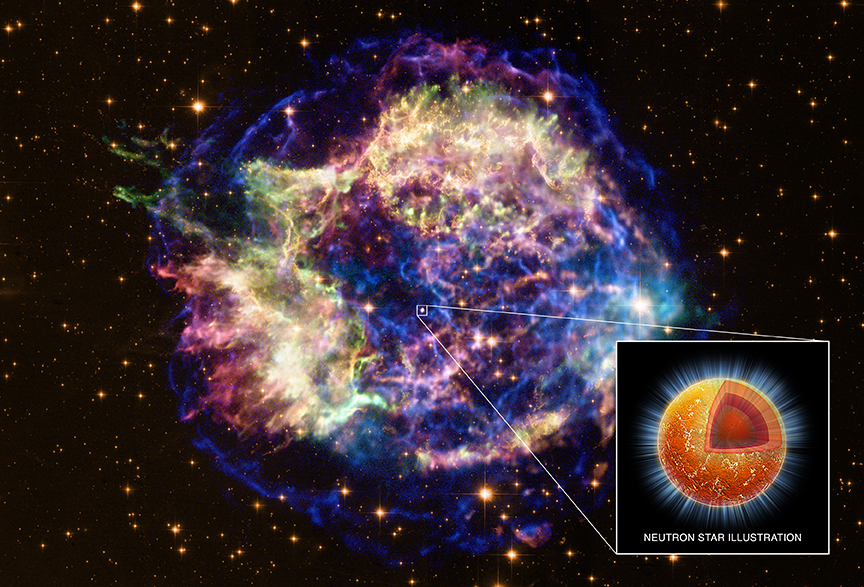Neutron stars like Cas A contain the densest known matter that is directly observable. One teaspoon of neutron star material weighs six billion tons. The pressure in the star's core is so high that most of the charged particles, electrons and protons, merge resulting in a star composed mostly of uncharged particles called neutrons.
NASA's Chandra X-ray Observatory has discovered the first direct evidence for a superfluid, a friction-free state of matter at the core of a neutron star. Superfluids created in laboratories on Earth exhibit remarkable properties, such as the ability to climb upward and escape airtight containers. Chandra data found a rapid decline in the temperature of the ultra-dense neutron star that remained after the supernova, showing that it had cooled by about four percent over a 10-year period.
"This drop in temperature, although it sounds small, was really dramatic and surprising to see," said Dany Page of the National Autonomous University in Mexico, leader of a team with a paper published in Physical Review Letters. "This means that something unusual is happening within this neutron star."

X-ray and optical view of Cassiopeia A (Cas A), a supernova remnant located in our Galaxy about 11,000 light years away. These are the remains of a massive star that exploded about 330 years ago, as measured in Earth's time frame. X-rays from Chandra are shown in red, green and blue along with optical data from Hubble in gold.
At the center of the image is a neutron star, an ultra-dense star created by the supernova. Ten years of observations with Chandra have revealed a 4% decline in the temperature of this neutron star, an unexpectedly rapid cooling. Two new papers by independent research teams show that this cooling is likely caused by a neutron superfluid forming in its central regions, the first direct evidence for this bizarre state of matter in the core of a neutron star.
The inset shows an artist's impression of the neutron star at the center of Cas A. The different colored layers in the cutout region show the crust (orange), the core (red), where densities are much higher, and the part of the core where the neutrons are thought to be in a superfluid state (inner red ball). The blue rays emanating from the center of the star represent the copious numbers of neutrinos -- nearly massless, weakly interacting particles -- that are created as the core temperature falls below a critical level and a neutron superfluid is formed, a process that began about 100 years ago as observed from Earth. These neutrinos escape from the star, taking energy with them and causing the star to cool much more rapidly. Credit: NASA
Superfluids containing charged particles are also superconductors, meaning they act as perfect electrical conductors and never lose energy. The new results strongly suggest that the remaining protons in the star's core are in a superfluid state and, because they carry a charge, also form a superconductor.
"The rapid cooling in Cas A's neutron star, seen with Chandra, is the first direct evidence that the cores of these neutron stars are, in fact, made of superfluid and superconducting material," said Peter Shternin of the Ioffe Institute in St Petersburg, Russia, leader of a team with a paper accepted in Monthly Notices of the Royal Astronomical Society.
Both teams show that this rapid cooling is explained by the formation of a neutron superfluid in the core of the neutron star within about the last 100 years as seen from Earth. The rapid cooling is expected to continue for a few decades and then it should slow down.
"It turns out that Cas A may be a gift from the Universe because we would have to catch a very young neutron star at just the right point in time," said Page's co-author Madappa Prakash, from Ohio University. "Sometimes a little good fortune can go a long way in science."
The onset of superfluidity in materials on Earth occurs at extremely low temperatures near absolute zero, but in neutron stars, it can occur at temperatures near a billion degrees Celsius. Until now there was a very large uncertainty in estimates of this critical temperature. This new research constrains the critical temperature to between one half a billion to just under a billion degrees.
Cas A will allow researchers to test models of how the strong nuclear force, which binds subatomic particles, behaves in ultradense matter. These results are also important for understanding a range of behavior in neutron stars, including "glitches," neutron star precession and pulsation, magnetar outbursts and the evolution of neutron star magnetic fields.
Small sudden changes in the spin rate of rotating neutron stars, called glitches, have previously given evidence for superfluid neutrons in the crust of a neutron star, where densities are much lower than seen in the core of the star. This latest news from Cas A unveils new information about the ultra-dense inner region of the neutron star.
"Previously we had no idea how extended superconductivity of protons was in a neutron star," said Shternin's co-author Dmitry Yakovlev, also from the Ioffe Institute.
The cooling in the Cas A neutron star was first discovered by co-author Craig Heinke, from the University of Alberta, Canada, and Wynn Ho from the University of Southampton, UK, in 2010. It was the first time that astronomers have measured the rate of cooling of a young neutron star.




Comments